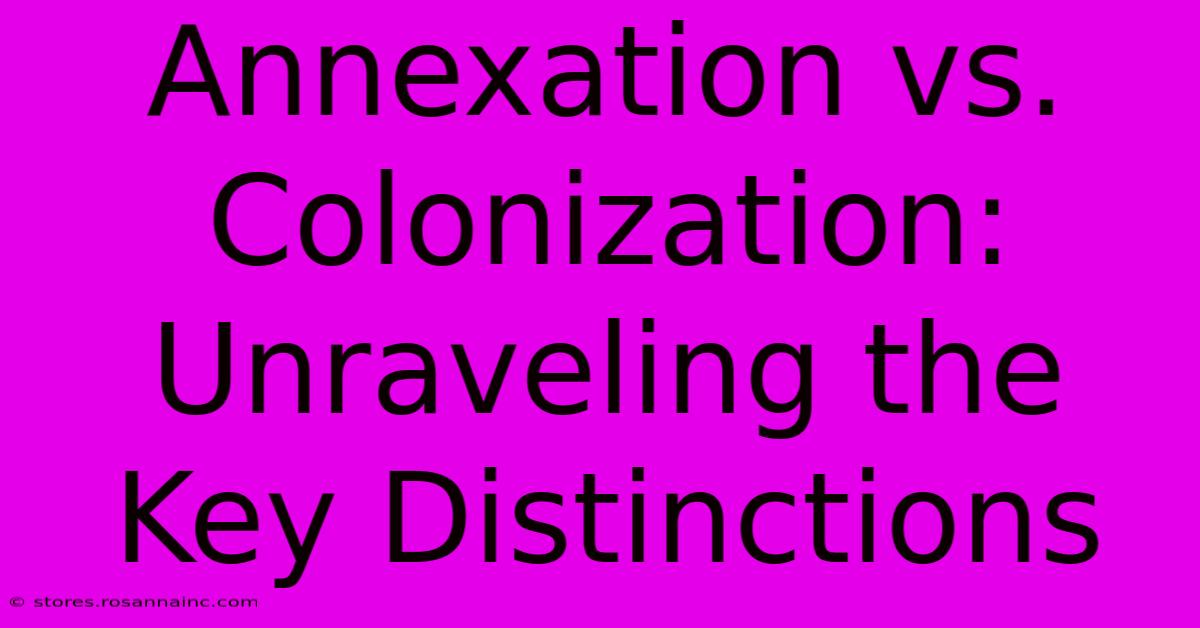Annexation Vs. Colonization: Unraveling The Key Distinctions

Table of Contents
Annexation vs. Colonization: Unraveling the Key Distinctions
The terms "annexation" and "colonization" are often used interchangeably, leading to confusion about their distinct meanings. While both involve the acquisition of territory by one entity from another, crucial differences exist in their processes, motivations, and consequences. Understanding these distinctions is vital for accurately interpreting historical events and contemporary geopolitical situations. This article delves into the key differences between annexation and colonization, exploring their historical contexts and providing clear examples.
Defining Annexation
Annexation refers to the formal incorporation of a territory into an existing political entity. This process typically involves the legal transfer of sovereignty, often through treaty, conquest, or purchase. The annexed territory becomes an integral part of the acquiring state, subject to its laws and governance. Crucially, annexation often, though not always, implies a degree of pre-existing political organization within the annexed territory. It's not necessarily about establishing a completely new system of rule from scratch.
Key Characteristics of Annexation:
- Formal legal process: Involves official acts and legal frameworks.
- Integration into existing state: The annexed territory becomes part of the existing political structure.
- Existing population: Often, a pre-existing population resides in the annexed territory.
- Focus on territorial expansion: Primarily driven by the desire to expand a state's borders and influence.
Defining Colonization
Colonization, conversely, is a far more complex and multifaceted process. It involves the establishment and growth of settlements in a territory by people from another territory, often involving a significant power imbalance. Colonization typically features the imposition of a new political, economic, and social system upon the indigenous population, often resulting in cultural disruption, exploitation, and subjugation. It's a process of settlement and control, frequently characterized by the displacement or marginalization of the native inhabitants.
Key Characteristics of Colonization:
- Establishment of new settlements: Involves the migration and establishment of new communities by colonizers.
- Imposition of a new system: Leads to the imposition of new political, economic, and social structures.
- Subjugation of indigenous population: Often involves the exploitation and oppression of the native population.
- Cultural transformation: Results in significant cultural changes and disruption for the indigenous population.
- Long-term control and exploitation: Aims at long-term dominance and extraction of resources.
Annexation vs. Colonization: A Comparative Table
| Feature | Annexation | Colonization |
|---|---|---|
| Process | Formal legal act; often involves treaty or conquest | Settlement, subjugation, and imposition of control |
| Motivation | Territorial expansion; strategic advantage | Resource extraction; expansion of power; settlement |
| Population | Existing population often incorporated | Indigenous population often displaced or marginalized |
| Cultural Impact | Relatively less profound cultural change | Significant cultural transformation and disruption |
| Power Dynamic | Relatively less asymmetrical power dynamic | Highly asymmetrical power dynamic |
Examples of Annexation and Colonization
Annexation: The annexation of Texas by the United States in 1845 is a prime example. Texas had previously been an independent republic, and its annexation was a formal legal process involving a treaty and the consent (however contentious) of the Texan population.
Colonization: The colonization of the Americas by European powers, such as the Spanish colonization of Mexico or the British colonization of North America, exemplifies this process. These involved large-scale migration, the establishment of new settlements, the displacement of indigenous populations, and the imposition of new political and economic systems.
The Overlap and Nuances
It's important to note that the distinction isn't always clear-cut. Some historical events exhibit aspects of both annexation and colonization. For instance, while the Roman Empire annexed various territories, its actions often involved elements of colonization through the establishment of Roman settlements and the imposition of Roman law and culture. The complexities of history often defy simple categorization.
Conclusion
Understanding the differences between annexation and colonization is crucial for a nuanced interpretation of historical and contemporary events. While both processes involve the acquisition of territory, the underlying motivations, processes, and consequences differ significantly. Annexation typically implies a more formal legal process and a greater degree of integration, while colonization involves settlement, subjugation, and often the displacement or marginalization of indigenous populations. By recognizing these distinctions, we can engage in a more informed and accurate analysis of geopolitical power dynamics and their impact on societies throughout history.

Thank you for visiting our website wich cover about Annexation Vs. Colonization: Unraveling The Key Distinctions. We hope the information provided has been useful to you. Feel free to contact us if you have any questions or need further assistance. See you next time and dont miss to bookmark.
Featured Posts
-
Warning Avoid These Stocks Like The Plague The Short Sale Restricted Blacklist Exposed
Feb 05, 2025
-
Outrageous Deception Top 10 Ads Exposed For Their False Claims
Feb 05, 2025
-
The Ultimate Installation Guide Avoid Pitfalls And Maximize Efficiency
Feb 05, 2025
-
Petal Perfect Savings Fifty Flowers Discount Code For All Your Floral Needs
Feb 05, 2025
-
Color Conundrum Solved Discover The Enchanted Child Of Green And Yellows Union
Feb 05, 2025
